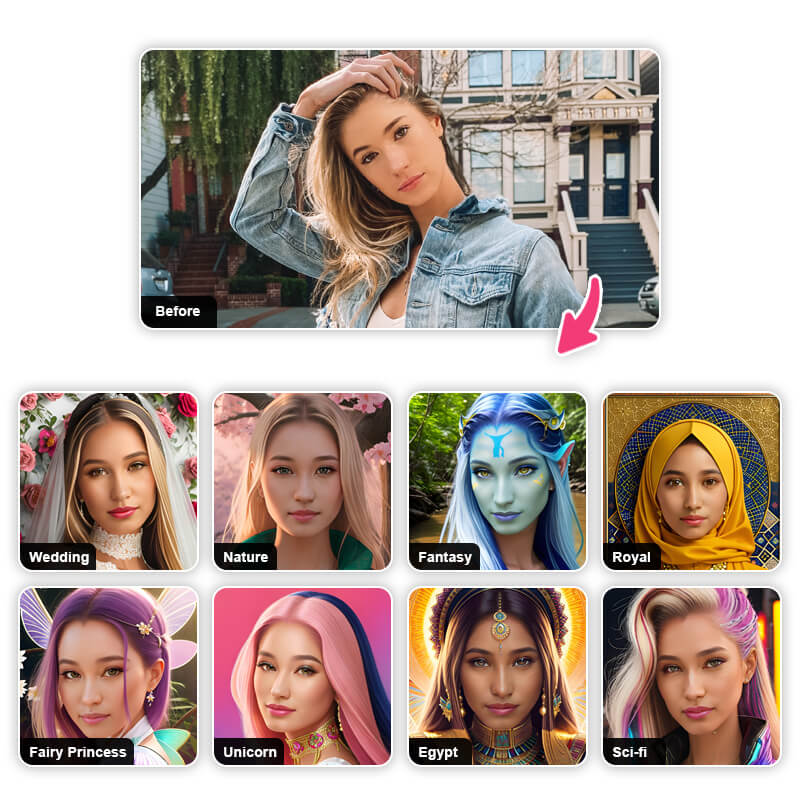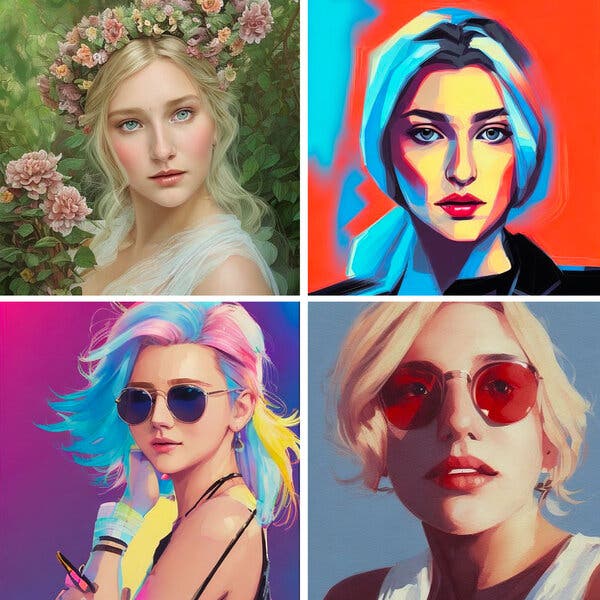The journey of
AI in image creation is a tale of rapid advancement and groundbreaking innovations. From its nascent stages to the sophisticated tools we have today, AI has dramatically transformed the landscape of visual content creation. This evolution can be mapped through several key milestones:
- Early Experiments: The initial experiments with AI in image creation were focused on basic pattern recognition and image classification. These rudimentary forms of AI, based on simple neural networks, set the foundation for more complex image processing tasks.
- Advent of Deep Learning: The introduction of deep learning, particularly Convolutional Neural Networks (CNNs), marked a significant leap. This enabled more sophisticated tasks like image and facial recognition, paving the way for more advanced applications.
- Generative Adversarial Networks (GANs): The development of GANs was a game-changer. Introduced by Ian Goodfellow and his colleagues in 2014, GANs involve two neural networks—the generator and the discriminator—working in tandem to create highly realistic images. This technology became the backbone of many modern AI image generation tools.
- Text-to-Image Models: Recent advancements have led to the creation of models that can generate images from textual descriptions. These models, like OpenAI's DALL-E, use a combination of natural language processing and image generation techniques to create images that closely match the given descriptions.
- Personalization and Customization: Today, AI image generation tools have evolved to offer a high degree of personalization. Users can create images of themselves, modify existing images, or generate unique visuals based on their specific preferences and inputs.
This timeline is not just a history lesson but an indicator of how rapidly AI is evolving. The following table highlights the key differences between early AI image tools and modern AI image generators:
| Aspect | Early AI Image Tools | Modern AI Image Generators |
|---|
| Technology | Basic Neural Networks | Advanced GANs, Deep Learning |
| Functionality | Basic Pattern Recognition | Highly Realistic Image Creation, Text-to-Image Conversion |
| User Input | Limited Interaction | Highly Interactive and Customizable |
| Image Quality | Basic and Generic | Detailed, High Quality, and Personalized |
| Applications | Primarily Academic and Experimental | Wide-ranging, including Personal, Professional, and Commercial |
The evolution of AI in image creation has not only enhanced the quality and capabilities of image generation tools but also democratized access to sophisticated visual content creation, allowing anyone to harness the power of AI for their personal or professional projects.
Understanding How Free AI Image Generators Work

Free AI image generators are fascinating tools that combine the power of artificial intelligence with user accessibility. To understand their workings, it's essential to delve into the core components and processes that enable these tools to turn text or basic inputs into vivid images. Here’s a breakdown of how these generators typically function:
- Data Collection and Training: AI image generators are trained on vast datasets of images and, in some cases, their corresponding descriptions. This training allows the AI to learn various styles, objects, and the nuances of image composition.
- Neural Networks: At the heart of these generators are neural networks, often Generative Adversarial Networks (GANs). One part of the GAN, the generator, creates images, while the other part, the discriminator, evaluates them. Through this process, the AI learns to produce more realistic images.
- User Input Interpretation: When a user inputs a text description or selects specific parameters, the AI uses natural language processing (NLP) to interpret these inputs and understand the desired outcome.
- Image Generation: Using the learned patterns and the user's input, the AI then generates an image. This process involves creating pixel-by-pixel compositions that align with the learned data and user specifications.
- Refinement and Delivery: The generated image may go through refinement processes to enhance quality and realism. The final image is then presented to the user.
Below is a table summarizing the key components of free AI image generators:
| Component | Description | Role in Image Generation |
|---|
| Training Datasets | Large collections of images and descriptions | Teaching the AI about various image styles and elements |
| Generative Adversarial Networks (GANs) | A framework involving two neural networks: a generator and a discriminator | Creating and refining images to enhance realism |
| Natural Language Processing (NLP) | AI's ability to understand and interpret human language | Decoding user inputs to guide the image generation process |
| Pixel-by-Pixel Composition | The method of creating images one pixel at a time | Building the final image based on AI learning and user input |
Free AI image generators are powerful tools that bring together complex AI technologies and user-friendly interfaces. By understanding their workings, users can better harness their capabilities for creative and practical applications.
Step-by-Step Guide to Creating Your AI Image
Creating an AI-generated image can be an exciting and creative experience. Whether you're looking to generate an artistic representation of yourself or bring a unique concept to life, AI image generators can make it happen. Here's a detailed, step-by-step guide to help you navigate this process:
- Select an AI Image Generator: Begin by choosing a free AI image generator that fits your needs. Look for one with a user-friendly interface and versatile capabilities. Websites like https://hdstockimages.com/ often offer a range of tools for different creative requirements.
- Conceptualize Your Idea: Have a clear idea or theme in mind. Whether it's a self-portrait, a fantasy scene, or an abstract concept, knowing what you want to create is key.
- Input Your Description: Most AI image generators use text-based inputs. Craft a detailed description of your image. The more specific you are, the better the AI can understand and create your vision.
- Adjust the Settings: Many AI tools offer customizable settings such as style, color palette, or image resolution. Adjust these to align with your vision.
- Generate the Image: Once your description and settings are in place, initiate the image generation process. The AI will process your input and start creating the image.
- Review the Outcome: Evaluate the generated image. AI image generation is an iterative process, and the first result might not be perfect.
- Make Adjustments: If possible, refine your description or tweak the settings, and regenerate the image until you're satisfied with the outcome.
- Save and Share: Once you're happy with the image, save it to your device. Many platforms also offer options to share your creation directly on social media or other platforms.
Here's a quick reference table summarizing these steps:
| Step | Details | Tips |
|---|
| 1. Select AI Generator | Choose a suitable AI image generation tool. | Look for user-friendly interfaces and diverse functionalities. |
| 2. Conceptualize Idea | Decide on the theme or subject of your image. | Be clear and imaginative with your concept. |
| 3. Input Description | Enter a detailed description for the AI. | The more detailed the description, the better the result. |
| 4. Adjust Settings | Customize settings like style and resolution. | Experiment with different settings for varied effects. |
| 5. Generate Image | Initiate the AI to create your image. | Be patient; some images may take time to generate. |
| 6. Review Outcome | Examine the generated image. | Look at it critically and decide if it matches your vision. |
| 7. Make Adjustments | Refine and regenerate if necessary. | Don't hesitate to make multiple iterations. |
| 8. Save and Share | Download the final image and share it if you wish. | Use built-in sharing options for convenience. |
This step-by-step guide will help you effectively use AI image generators to bring your creative visions to life, regardless of your technical expertise.
Benefits of Using AI for Personal Image Creation
Artificial Intelligence (AI) has revolutionized the field of personal image creation, offering a range of benefits that were unimaginable just a few years ago. From amateur artists to professional designers, AI image generators have become invaluable tools. Let's delve into the key advantages of using AI for creating personalized images:
- Enhanced Creativity: AI opens up a world of creative possibilities, allowing users to explore and create images beyond the limits of traditional methods. It offers a chance to experiment with different styles, textures, and concepts effortlessly.
- Time-Saving: Traditional image creation can be time-intensive, involving multiple stages from sketching to coloring. AI significantly reduces the time required, generating complex images within minutes.
- Cost-Effective: Acquiring advanced software or hiring professional artists can be costly. AI image generators, especially free ones, provide a cost-effective alternative for high-quality image creation.
- Accessibility for All Skill Levels: AI tools democratize the art of image creation, making it accessible to people regardless of their artistic skills or technical knowledge.
- Customization: AI generators offer a high degree of customization, enabling users to create images that are tailored to their specific preferences and needs.
- Innovative Learning Tool: These platforms serve as an excellent learning resource, helping individuals understand and experiment with various artistic styles and techniques.
- Continual Evolution: AI technology is constantly evolving, bringing improvements and new features that enhance the quality and variety of images one can create.
Let's summarize these benefits in a table for a quick overview:
| Benefit | Description | Impact |
|---|
| Enhanced Creativity | AI facilitates the exploration of diverse artistic styles and ideas. | Encourages creative experimentation and expression. |
| Time-Saving | Quick image generation compared to traditional methods. | Efficiently produces images, saving valuable time. |
| Cost-Effective | Reduces the need for expensive software or professional services. | Makes high-quality image creation more affordable. |
| Accessibility for All Skill Levels | User-friendly interfaces that do not require advanced skills. | Makes image creation accessible to a broader audience. |
| Customization | AI allows for detailed personalization of images. | Enables creation of images that align closely with user preferences. |
| Innovative Learning Tool | Provides an opportunity to learn about various art styles and techniques. | Enhances artistic knowledge and skills. |
| Continual Evolution | Ongoing advancements in AI technology. | Ensures ever-improving capabilities and features in image generation. |
These benefits highlight why AI has become a game-changer in personal image creation, offering an unparalleled blend of creativity, efficiency, and accessibility.
Comparing Free AI Image Generators: Features and Quality
In the realm of
AI image generation, various free tools offer a spectrum of features and qualities. Selecting the right one can significantly impact the effectiveness and satisfaction of your creative endeavors. Let's compare key aspects of these generators to understand what sets them apart.
- Artistic Styles and Flexibility: The range of styles available (from realistic to abstract) varies across platforms. Some tools are more versatile, offering a broader spectrum of artistic expressions.
- Image Resolution and Quality: High-resolution outputs are vital for detail and clarity, especially for professional use. Free tools often have limitations in resolution compared to paid versions.
- User Interface and Experience: A user-friendly interface is crucial for ease of use, particularly for beginners. The complexity of interfaces can range from simple, intuitive designs to more sophisticated, feature-rich options.
- Customization Options: The ability to tweak and fine-tune images – such as adjusting colors, textures, and incorporating specific elements – is a significant aspect of these tools.
- Processing Speed: The time taken to generate images can vary. While some tools offer near-instant results, others might take longer but could potentially deliver higher-quality images.
- Input Method Flexibility: The types of input (text, images, etc.) that a tool can process, and how well it interprets these inputs, is key to its versatility and ease of use.
Here's a table that offers a comparative glance:
| Feature | Importance | Variability Among Free Generators |
|---|
| Artistic Styles and Flexibility | Crucial for creative expression | Varies from limited to extensive |
| Image Resolution and Quality | Essential for professional-grade output | Often capped; higher resolutions usually in premium versions |
| User Interface and Experience | Key for usability and accessibility | Range from simple and intuitive to complex and feature-rich |
| Customization Options | Important for personalized results | Basic to advanced, depending on the tool |
| Processing Speed | Vital for efficiency | From near-instant to longer processing times |
| Input Method Flexibility | Impacts overall functionality | Diverse, from text-based to upload-centric inputs |
Understanding these features and their variability can help in choosing the most suitable free AI image generator for your specific needs, whether for casual experimentation or more refined artistic creations.
Creative Ways to Use AI-Generated Images of Yourself
AI-generated images offer an innovative canvas for creativity, especially when they feature your own likeness. These images can be used in a multitude of ways, ranging from personal branding to artistic expression. Here are some creative applications for AI-generated images of yourself:
- Personal Branding: Enhance your online presence by using AI-generated images on social media profiles, personal websites, or blogs. These unique images can make you stand out in the digital world.
- Artistic Expression: Incorporate AI-generated self-portraits into your digital artwork. This can add a unique flair to your creations, whether they are surreal, abstract, or realistic.
- Virtual Avatars: In the realm of online gaming, VR, or social platforms, use AI to create distinctive avatars that represent your persona in these virtual spaces.
- Custom Merchandise: Print your AI-generated images on merchandise like T-shirts, coffee mugs, or posters. These can serve as personalized gifts or unique items for sale.
- Storytelling: For authors or content creators, AI-generated images can bring characters to life, providing a visual representation for stories or promotional materials.
- Professional Presentations: Give a personal touch to business presentations, reports, or marketing materials with AI-generated images that maintain a professional edge.
- Educational Content: Teachers and educators can utilize these images to create more engaging and relatable educational materials for students.
- Photography and Filmmaking: Use AI-generated images as a tool for planning shots, scenes, or for inspiration in visual storytelling.
Here's a summary table for easy reference:
| Application | Description | Potential Use Cases |
|---|
| Personal Branding | Unique digital identity | Social media, websites, blogs |
| Artistic Expression | Enhancing digital art | Art projects, digital canvases |
| Virtual Avatars | Personalized digital representation | Gaming, VR, social platforms |
| Custom Merchandise | Personalized items with a unique touch | T-shirts, mugs, posters |
| Storytelling | Visual aid for narratives | Book covers, content creation |
| Professional Presentations | Unique visuals for business | Presentations, reports, marketing |
| Educational Content | Engaging learning materials | Classroom teaching, online courses |
| Photography and Filmmaking | Visual planning and inspiration | Shot planning, scene setting |
These are just a few ways AI-generated images can be creatively utilized, highlighting the blend of technology and personal creativity.
Future Trends in AI Image Generation Technology
The realm of AI image generation is rapidly evolving, with new advancements reshaping how we create and interact with digital imagery. As we look to the future, several trends are emerging that promise to further revolutionize this field. Here's an exploration of what we can expect in the coming years:
- Increased Realism: Future AI image generators are likely to produce even more realistic and high-resolution images. This will blur the lines between AI-generated images and actual photographs, offering unparalleled realism in digital creations.
- Enhanced Customization: Upcoming advancements will likely allow for more detailed customization, enabling users to fine-tune images to a greater degree. This includes better control over aspects like lighting, textures, and expressions in AI-generated portraits.
- Greater Accessibility: As technology progresses, AI image generation tools will become more user-friendly and accessible to a broader audience, not just professionals or tech enthusiasts.
- Integration with Other Technologies: We can expect to see AI image generation being integrated with other technologies like virtual reality (VR), augmented reality (AR), and 3D printing, broadening its applications.
- Interactive AI Art: The future might hold interactive AI art experiences, where AI-generated images can change or evolve in response to viewer interactions or environmental factors.
- AI in Filmmaking and Gaming: The film and gaming industries will likely embrace AI for more efficient and realistic character creation, scene design, and even dynamic story development.
- Personal AI Art Assistants: Imagine having a personal AI assistant that understands your artistic style and preferences, helping you create tailored images or suggesting modifications to your work.
- Ethical and Legal Frameworks: As AI image generation becomes more prevalent, robust ethical and legal frameworks will be established to address issues related to copyright, privacy, and the ethical use of AI-generated imagery.
Here's a summary table of these trends:
| Trend | Impact | Potential Applications |
|---|
| Increased Realism | Hyper-realistic digital images | Art, advertising, entertainment |
| Enhanced Customization | More control over image details | Personalized art, design work |
| Greater Accessibility | Easier for all users | Education, amateur art creation |
| Integration with Other Tech | Broader application scope | VR, AR, 3D printing |
| Interactive AI Art | Dynamic, responsive art pieces | Exhibitions, public installations |
| AI in Filmmaking and Gaming | Enhanced creative processes | Character design, story development |
| Personal AI Art Assistants | Personalized artistic aid | Individual artists, designers |
| Ethical and Legal Frameworks | Regulation of AI art use | Legal, ethical considerations |
As these trends unfold, the future of AI image generation looks incredibly promising, heralding a new era of creativity and technological synergy.
FAQs
When exploring the exciting world of AI-generated images, many questions may arise. Here are some frequently asked questions to help you understand this innovative technology better:
- What is AI Image Generation?
- AI Image Generation refers to the process of creating images, artwork, or visual content using artificial intelligence technologies. It involves algorithms that can analyze data and generate new images based on given inputs or parameters.
- How accurate are AI-generated images?
- The accuracy of AI-generated images depends on the algorithm and data it's trained on. Modern AI image generators can produce highly realistic and detailed images, but they may not always be 100% accurate in replicating real-life scenarios.
- Can AI create images from text descriptions?
- Yes, many advanced AI image generators can create images from text descriptions, interpreting and visualizing the text input into a corresponding image.
- Is it possible to edit AI-generated images?
- Yes, AI-generated images can be edited like any other digital images using standard image editing software.
- Are AI-generated images copyright-free?
- The copyright status of AI-generated images can vary. It's essential to check the terms of use of the AI image generator platform and be aware of any copyright laws that may apply.
- Can AI image generators replicate famous artwork styles?
- Yes, many AI image generators can replicate various art styles, including those of famous artists, by analyzing and learning from a dataset of those particular styles.
- How long does it take to generate an image using AI?
- The time it takes to generate an image can vary depending on the complexity of the request and the capabilities of the AI system, ranging from a few seconds to several minutes.
- Are AI image generators easy to use for beginners?
- Many AI image generators are designed with user-friendly interfaces, making them accessible even for beginners. However, the ease of use can vary between different tools.
Conclusion
The exploration of AI image generation opens up a fascinating world of possibilities, blending technology and creativity in unprecedented ways. As we've seen, AI's role in image creation is not just a fleeting trend but a significant leap forward in how we produce and interact with digital imagery. From the early stages of computer graphics to the sophisticated AI algorithms of today, the journey has been remarkable. The potential for personal, artistic, and commercial applications is vast, and the technology is becoming increasingly accessible to a wider audience.However, as we embrace these advancements, it's crucial to remain mindful of the ethical and legal implications. The balance between innovation and responsible use will be key in shaping the future of AI in image generation. Whether you're a professional artist, a hobbyist, or simply someone fascinated by the merger of art and technology, the era of AI-generated imagery promises a canvas limited only by our imagination.In conclusion, as AI continues to evolve and integrate more seamlessly into our digital lives, the potential for creating, sharing, and experiencing AI-generated images will only grow. This journey into the realm of AI-generated imagery is just beginning, and it's an exciting time to be part of this evolving landscape.
 Free AI image generators are fascinating tools that combine the power of artificial intelligence with user accessibility. To understand their workings, it's essential to delve into the core components and processes that enable these tools to turn text or basic inputs into vivid images. Here’s a breakdown of how these generators typically function:
Free AI image generators are fascinating tools that combine the power of artificial intelligence with user accessibility. To understand their workings, it's essential to delve into the core components and processes that enable these tools to turn text or basic inputs into vivid images. Here’s a breakdown of how these generators typically function:
 admin
admin








